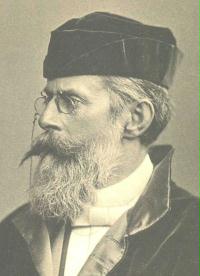
Heinrich von Herzogenberg (1843-1900/헌종8년-고종36년 57세)
Heinrich von Herzogenberg (1843,-1900)는 프랑스 혈통의 귀족가문출신의 오스트리아
작곡가이자 지휘자였다. 비엔나에서 음악과 법률을 공부했으며 후에 Felix Otto Dessoff
에게 작곡을 배웠다..그는 일찌기 바그너에게 매료되었으나 J. S. Bach 에대한 공부를
통하여 클래식의 전통적인 부분에 강력한 매력을 느끼게 되었으며 브람스의 열렬한
지지자가 되었다...그는 브람스의 파아노 제자였던 Elisabet von Stockhausen과 결혼
했는데 브람스와 Herzogenberg 부부 사이에는 서로 주고 받은 편지의 내용으로 볼 때
누구보다도 잘 일치하는 연대감이 조성되었다. (Heinrich Picot de Peccaduc, Freiherr von Herzogenberg ( 1843 - 1900) was an Austrian composer and conductor descended from a French aristocratic family.)
-------------------------------------------------------------------------------------------------
Symphony No.2 in B-flat major, Op.70 (1889)
Orchestra: Sinfonieorchester St. Gallen / Conductor: Henrik Nanasi
Mov.I: Allegro 00:00
Mov.II: Andante quasi allegretto 11:02
Mov.III: Allegro moderato 18:02
Mov.IV: Allegro con brio 24:36
================================================================================
* Piano Trio No.1 c minor Op.24
===============================================================================
Piano Trio No.2 D minor Op.36
===============================================================================
* Trio in D Major for violin (orig. oboe), horn and piano, op. 61
I. Allegretto
II. Presto
III. Andante con moto
IV. Allegro
===============================================================================

Heinrich von Herzogenberg & Elisabet Herzogenberg
1874년에 Bach scholar Philipp Spitta와 함께 Leipzi Bach-Verein을 창립했는데 이는
바흐의 칸타타를 재연하기 위함 이었으며 Herzogenberg 는 10년 동안 그 예술 감독 자리를
맡았다. 이 시기에 영국에서 온 에델 스미스Dame Ethel Mary Smyth ( 1858-1944) 가 그
밑에서 작곡을 공부하던 시기였다.
1885년 부터 베르린의 Hochschule für Musik에서 작곡과 교수로 일했는데 당시 그를 찾은
젊은 본 윌리엄스를 막스 부르흐 밑에서 공부하도록 배려하기도 했다. 그의 마지막 해에는
관절의 괴사로 인해 휠체어에 같혀 살다가 그의 나이 57세를 일기로 세상을 마감했다,,
Herzogenberg 는 한정된 재능의 학구적인 작곡가였다. 그는 작곡가로서 최초 작품으로
브람스 주제에 의한 변주곡을 썼으나 그의 부인이 되었던 엘리자벳의 브람스에 대한 아첨
에도 불구하고 대부분은 그의 작품에 대해 긍적적인 동의를 하지 않았다. 그런 일로 매우
감정을 상했던 그는 그 자신을 극도로 좋아하던 엘리자벳과 결혼을 결심 하게 된 것으로
세인들은 추론하고 있다.
그의 삶이 끝나갈 무렵 브람스는 부드럽지만 인색하게 다음과 같이
이야기 했다고 한다...
"Herzogenberg는 다른 누구보다 더 많이 작곡할 수 있었는데."
Herzogenberg는 왕왕 브람스 아류 작곡가로 평가되는 경향을 갖고 있는데 브람스와 일정한
친분관계가 갖기 전에 작곡된 두곡의 string trios Op.27 Nos. 1 & 2 역시 선배 작곡가가 가지는
공통의 특징을 드러내보이는 것 처럼 그의 작품들은 일정하게 브람스 영향을 받은 것으로
인정된다..
죽음이 그 앞에 임박했을 때 그 자신은 비록 카톨릭으로 남아 있었으나 루터교 Evangelical
Church의 공동 예배를 위한 작품을 작곡하는데 주력한 것으로 알려져 있다..
Herzogenberg의 주된 작품들 다수가 2차 대전동안 상당부분 유실 된 것으로 알려져 있으며
상당한 기간동안 잊혀졋던 작곡가인 Herzogenberg는 1990년대에 들어서면서 서서히 수면
위로 부상하기 시작했다 .
Heinrich Picot de Peccaduc, Freiherr von Herzogenberg (10 June 1843 – 9 October 1900)
was an Austrian composer and conductor descended from a French aristocratic family.
He was born in Graz and was educated at a Jesuit school in Feldkirch and also in Munich, Dresden and Graz before studying law, philosophy and political science at the university of Vienna. He soon turned his energies to music and attended the composition classes of Felix Otto Dessoff until 1864. Early on he was attracted to the music of Richard Wagner, but after studying J. S. Bach's works he became an adherent of the classical tradition and became an advocate for the music of Brahms. In 1866 he married Elisabet von Stockhausen, who had been a piano pupil of Brahms; Brahms's letters to and from both Herzogenbergs form one of the most delightful sections of his correspondence. They lived in Graz until 1872, when they moved to Leipzig: in 1874, with the Bach scholar Philipp Spitta, Herzogenberg founded the Leipzig Bach-Verein, which concerned itself with the revival of Bach’s cantatas. Herzogenberg was its artistic director for ten years, during which time Ethel Smyth was one of his composition pupils. From 1885 he was Professor of Composition at the Hochschule für Musik in Berlin: it was in this capacity that he advised the young Ralph Vaughan Williams to study with Max Bruch. He died suddenly in Wiesbaden, aged 57; in his last years he used a wheelchair due to necrosis of the joints.
Herzogenberg was a well-schooled composer of definite gifts, and was the first to write a set of Variations on a theme of Brahms (his op.23, for four hands at one piano, composed in 1876 on the Brahms song, Die Trauernde, op.7 no.5), but despite Elisabet’s cajoling Brahms almost never expressed approval of his works. It has been suggested that he was piqued that Herzogenberg had married Elisabet, of whom he was himself extremely fond.
Toward the end of his life,Brahms grudgingly relented somewhat writing,
“Herzogenberg is able to do more than any of the others.”
While Herzogenberg has tended to be characterized as a mere epigone of Brahms, many of his compositions show little or no overt Brahmsian influence, for example his two string trios Op.27 Nos. 1 & 2, while some early compositions pre-dating his acquaintance with Brahms have features in common with the older composer.
Towards the end of his life he concentrated on providing music for communal worship in the Lutheran Evangelical Church in Strasbourg, under the influence of Friedrich Spitta, brother of Philipp Spitta, who was professor of theology there, though Herzogenberg himself remained Roman Catholic. His models in these pieces were the Bach oratorios and passions, with chorales designed to be sung by the congregation and only a small instrumental ensemble. He also wrote a large-scale Mass in memory of Philipp Spitta, for which Friedrich Spitta selected the text. Several of Herzogenberg’s major works were thought to have been destroyed during World War II but resurfaced during the 1990s.
* 출처: 영어 위키백과
'♣ 음악 감상실 ♣ > [1840년 ~1859년]' 카테고리의 다른 글
| [프랑스]Augusta Mary Anne Holmes (0) | 2014.10.08 |
|---|---|
| [체코]Zdeněk Fibich [(즈데네크 피비히] (0) | 2014.10.04 |
| [프랑스] André Gedalge (0) | 2014.10.01 |
| [이탈리아]Giovanni Sgambati (0) | 2014.09.27 |
| [덴마크]Peter Lange Müller (0) | 2014.09.08 |